
| ICE Case Studies
|
|
I.
Case Background |

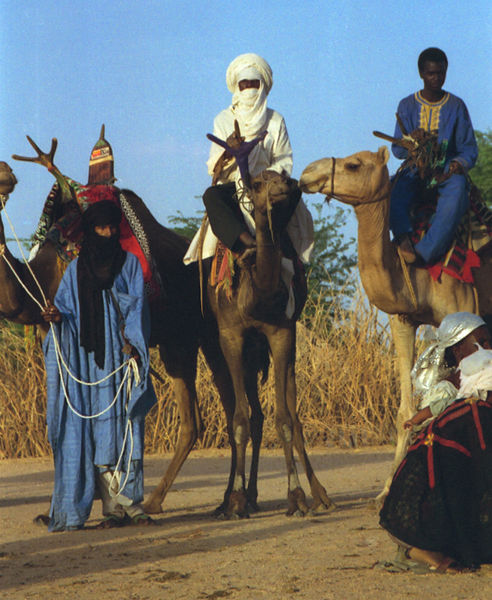
Image from Wikipedia Commons
Tuaregs are traditionally nomadic, but are facing difficult times
Abstract
Long standing tension and unresolved conflicts between Tuareg groups and the governments of Mali and Niger lay the basis for a high potential of violent conflict in the future; climate change exacerbates this likelihood. As it becomes harder to live off the Sahel, Tuaregs will not only have to adopt their nomadic lifestyle or migrate, but will become further disenchanted with the governments of Mali and Niger. While environmental migration could lead to conflicts with any group of refugees, already existing tension with the Tuareg population makes it even more likely.
Description
The many contributing factors to the likelihood of violent conflicts involving the Tuaregs in Mali and Niger in the future due to climate change include: the low standard of living, high population growth rates, social fragmentation, that the majority of the populations are subsistence farmers, lack of infrastructure, and inequality along group lines. Also important are the past cases of violent conflict including four major rebellions spanning from 1916 to present day. The potential for conflict is omnipresent, especially in the coming years, as desertification creates further resource strain. Lands the Tuaregs live off of will become less productive, and the increased severity and frequency of droughts and floods will threaten the Tuareg way of life. In addition, the large areas in the Sahara that the Tuareg inhabit have recently been discovered to harbor vast quantities of oil and uranium, the processing of which causes further strain on the land. Increased extraction of these will cause more tension; in the past Tuaregs have felt they don't receive the benefits from the exploitation that occurs in their homeland. [1]
Since colonialism, against which the Tuaregs heavily resisted, the Tuaregs have felt marginalized by the governments of Niger and Mali. Over the years, various rebel groups have formed over the issue that the governments have failed to tackle Tuareg poverty. In the various rebellions, the Tuaregs have been fighting for one of two things: for greater government representation and greater decentralization or for political autonomy. The rebellion in the 1990’s was a Tuareg secessionist movement to create an independent, separate state. This was resolved by peace accords in 1992 in Mali and 1995 in Niger. With the signing of the accords, in addition to greater decentralization and integration of Tuareg fighters into the national armies, the governments promised improved development of health care, education, and environmental protection. In the years after, the Tuaregs felt betrayed by lack of government effort to follow through, and rebellion again broke out in Niger in 2007 and spread to Mali by 2008.[2] In Niger, the rebellion is led by the Niger Movement for Justice (MNJ), and they continue to fight for greater autonomy. In Mali, there were more peace accords signed in 2008, but outbreaks of violence still occur; the leading rebels are the Democratic Alliance for Change. Simanowitz writes that the fighting has been followed by severe government crackdowns on the Tuaregs in Niger. In 2009, several government successes led to the surrender of hundreds of rebels, and hopes for a new peace process.[3]
In the future, increased desertification will create more strain on the nomadic way of life and cause various ethnic groups to migrate, creating more social tension. In addition, recent years of serious drought have caused terrible food insecurity. To make matters worse, this year horrible floods in Niger have left over 100,000 displaced, a preview of the sort of damage these disasters can create. As climate change increases, these disasters will occur more often and in greater intensity, putting populations already suffering (Oxfam estimates that over half the population of Niger is already facing hunger) into more danger.[4]
A very significant issue for the future of both countries is population growth. Already fragile states will have to cope with booming populations: Growth rates in these two countries are some of the highest in the world: Niger- 3.66%, and Mali- 2.61%. Niger's population will grow from only 15,878,271 today to 55,304,449 in 2050. Mali's will grow from 13,796,354 today to 32,367,436 in 2050. This is extraordinary and will place an even greater strain on infrastructure and the governments' abilities to provide basic services. To make matters worse, real GDP growth rate for 2009 in each country was negative: in Niger it was -1.20% and in Mali -4.40%.[5] Niger has the third lowest Human Development Index ranking in the world. The Failed States Index categorizes Niger at "Alert" and Mali at "Warning." For the following categories, ratings are out of ten, with ten being the worst level of each category. These countries had very troubling ratings for each category. Legacy of vengeance-seeking group grievance or group paranoia is especially a problem in Niger at 8.5, also in Mali at 6.5. Uneven economic development along group lines is problematic in both: Niger at 7.6, Mali at 6.9. Suspension or Arbitrary Application of the Rule of Law and Widespread Violation of Human Rights was problematic more in Niger at 8.2. The rise of factionalized elites is hugely problematic in Niger at 7.1.[6]
Niger is racked by serious political problems at the top as well: after a coup in February of this year, the transitional government has announced elections will be held in January 2011. Their membership in ECOWAS was suspended after a failure to postpone elections by former president Tandja (one of the contributing factors of the coup).[7] The literacy rate is only 28.7% (and only 15% for females). And around 50% of the population is under the age of 15. Nearly half of the government’s budget is from foreign aid. [8]
Mali is substantially more stable than Niger, but still has many problems. Since the first democratic elections in 1992, Mali has enjoyed relative political stability. However, nearly 50% of Mali’s population is also under 15 years old. The rate of urbanization here is 4.8%. The literacy rate is 46.4%, higher than Niger’s but still staggeringly low. As of 2004, the rate of unemployment was 30%; 80% of those employed were in agriculture.[9]
As I am only predicting a high likelihood of conflict in the future, it is difficult to put an exact date, but the impacts of climate change will be significant by 2050, as will the impacts of population growth. Therefore, the timeframe is from 2050 forward, and because the conflict has manifested itself repeatedly over the last few decades, renewed conflit could last decades.
Continent: Africa (Sub-Sahara)
Region: West Africa
Country: Mali, Niger
The conflict has taken place in Mali and Niger, but the governments of Algeria and Libya have also historically been involved. Due to the nature of desertification, the potential for conflict spreads to all nations with Tuareg populations (Algeria, Libya, Niger, Mali, and Burkina Faso), and even neighboring countries that may have to accommodate refugees of climate change.
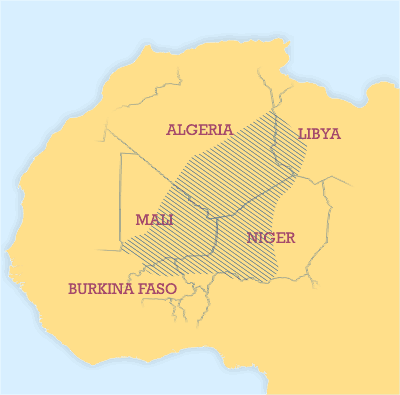
Picture from Wikipedia Commons
The shaded area shows the area Tuaregs typically inhabit.
| Image from Wikipedia Commons |
An MJN fighter |
The actors are the rebel groups, including MJN (Niger) and Democratic Alliance for Change (Mali), and the governments of the countries involved. The MNJ is now very well armed and organized: they have GPS, satellite phones, and a power structure with contacts as far as Europe. They attack in guerilla style: quickly then disappear into the desert.[10]
The ethnic groups in Niger are: Hausa 55.4%, Djerma Sonrai 21%, Tuareg 9.3%, Peuhl 8.5%, Kanouri Manga 4.7%, other 1.2%. The ethnic groups are Mande 50% (Bambara, Malinke, and Soninke), Peuhl 17%, Voltaic 12%, Songhai 6%, Tuareg and Moor 10%, other 5%.[11]
Because of the escalation of uranium mining and oil extraction, and the US’ war on terror, the conflict could expand to involve a much greater quantity of actors. France and China have both been trading uranium; while France has been viewed as sympathetic to the rebels, a Chinese uranium worker was taken hostage, ostensibly to discourage China from backing the Niger government. And though the extent of radical Islamic groups having much power in the Sahel, the region has recently been an important zone to the US strategy in the war on terror, in attempt to prevent terrorists from gaining a foothold in Africa. [12]

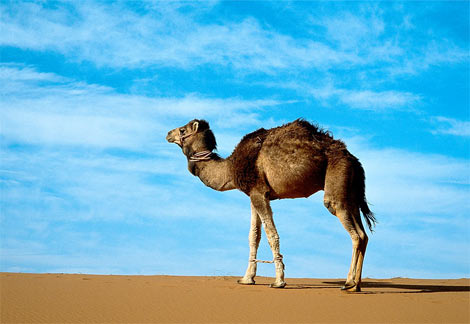 II. Environment Aspects
II. Environment Aspects
Type of Environmental Problem
Click on the icons on the map to find out more about each individual environmental problem

Figure 1: Environmental problems
There are various environmental problems involved: increased severity and frequency of droughts and floods, desertification, and decreased agricultural productivity. As the temperature increases, there will be longer and more frequent droughts. And as the land is damaged by these droughts, floods will be more severe. In addition, areas with few trees, such as the Sahara, are more susceptible to droughts. The Sahara is quickly growing southward, taking over land of the Sahel, and pushing the dividing line between North and South in West Africa further, adding to already high tensions between predominately Muslim and Christian, respectively, populations. And agricultural productivity in the two countries could decrease as much as 50% by 2080, perhaps the most frightening aspect of all, as the majority of people in this region are subsistence farmers.
Desertification: Another significant problem, not just for basic goods and loss of land, but for conflict dynamics, is desertification. “Sahara desertification will probably creep southward into heavily populated West Africa. Human land use will amplify this trend.”[13] West Africa is tenuously divided between North and South, with a predominately Muslim North and predominately Christian south. As the Sahel and Sahara move south, this will only push further strain on the religious divide that has historically and recently created conflict. Even on a more local level, we already see the effects of desertification on violence: "As climate change steps up the pace of desertification in the region, competition for resources has reached deadly levels."[14]
Droughts and Floods: An IPCC report showed that the number of extremely dry and wet years will increase during the present century. This will have major implications for numerous Africans and has long contributed to “human migration, cultural separation, population dislocation and the collapse of prehistoric and early historic societies.”[15] One-third of the people in Africa live in drought-prone areas. The impact of floods is worsened by prolonged droughts, as the land is less capable of dealing with water. Floods also bring about humanitarian disasters and epidemics, particularly diarrhea, cholera and malaria, which will worsen the effects of floods. We have seen these problems in the recent floods in Niger. As the temperature of the Sahel increases, more moisture will be evaporated, leading to longer and more common droughts. At times when rain actually does fall on the Sahel, the region will in result be more susceptible to flooding. We have seen early warning signs of this in the region this summer, as thousands have been displaced due to flooding in Niger, recently prey to severe drought.[16]
Agricultural Productivity: Food security will be directly threatened by climate change. Further insecurity could place millions on the brink of starvation in a region where the majority of people are subsistence farmers. As growing seasons become shorter and yields smaller, the situation will become dire.[17] James McCann describes how crucial the pattern of rainfall is: "In Africa it is rainfall rather than temperature that is the most relevant climatic limiting factor of food production.The timing of rainfall and its particular relationship to the constellation of labor, cropping patterns, and capital requirements of a specific African farming system is a critical but neglected aspect of both the historical and contemporary development of rural society and economy. It is, after all, the patterns of seasonal rainfall that trigger social and economic processes of labor, renewal of resources (food, seed, cash crops, and forage) and the shortage or abundance of harvests."[18]
Mining: Another issue (not on the map) The mining of uranium and oil will cause further and immediate environmental issues. Uranium extraction requires vast amounts of water, draining it from the surrounding areas. Accidents with both minerals can be devastating. And, “mining, the Tuareg say, has damaged valuable pastoral lands; while revenues have failed to benefit local communities.” Currently, there are thirty new projects planned for resource exploration and development, creating more concerns that Tuaregs" will suffer the consequences of these projects without receiving any of the benefits.”[19]
Dry
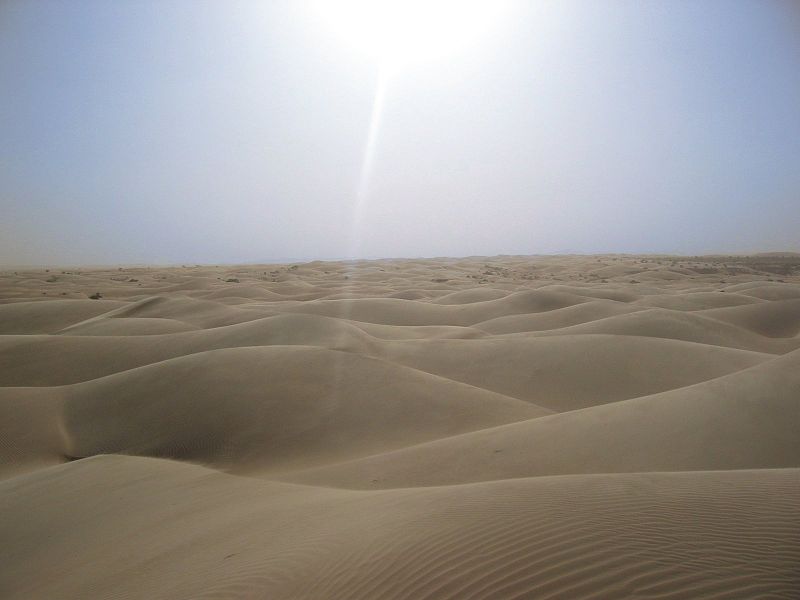
Image from Wikipedia Commons
As the Sahara creeps south, the habitat will become drier and become more uninhabitable
Both sites area Mali and Niger and the surrounding areas

 III. Conflict Aspects
III. Conflict Aspects(a) International
(b) Civil
The nature of the conflicts in the past has been mostly internal, while negotiations have been international. However, in the future, the conflict is likely to be completely international as regional networks expand and desertification expands to affect more populations. The conflict, between governments and rebel groups has resulted in heavy civilian causalities, and this is likely to be the case for future conflict as well.
The numbers of deaths in the past outbreaks of violence have been relatively low; hopefully this trend will continue.
The rebellion in Mali from 1990-1995 took 1,000 lives. The outbreak of violence from 2007-2008 took 97 lives.
In the 1994 conflict in Niger, 400 lives were lost. In the current conflict, 128 have died so far. [20]
Low

 IV. Environment and Conflict Overlap
IV. Environment and Conflict Overlap
Causal Diagram
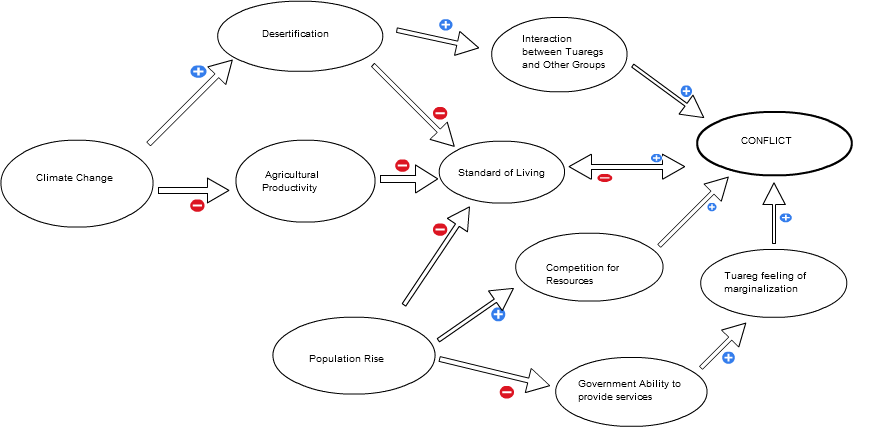
Figure 2: The effects of Climate Change and Population Rise on Conflict
This causal diagram explains the possible relationship of climate change in the Sahel, particularly Mali and Niger, with the added variable of a high population increase, to conflict in the future. In the future, and there are already signs of this, climate change will lead to desertification, a decrease in agricultural productivity, and an increase in droughts and floods (not shown on the diagram). Among other things, desertification will lead to an immediate decrease in the standard of living and/or migration. These can both lead to conflict. Decreased agricultural productivity will lead to an immediate (and substantial) decrease in the standard of living. Populations that will more than double (more than triple in Niger's case) will severely lower the standard of living as there will be increased strain on the environment, increased competition for resources, and decreased ability of the government to provide resources.
These two countries have also already experienced violent conflict and years of tension with the Tuareg population, whose nomadic lifestyle has historically been discriminated against. As the quality of life of Tuaregs decreases due to food shortages and loss of land, and their overall standard of living decreases, there is a possibility that they will migrate to regions of greater opportunity, interacting with new groups, some of which may be hostile. As migration occurs, there is always possibility for violence. The Tuaregs will have to compete for jobs in already crowded urban centers if they choose to move to cities within Niger and Mali. If they choose to move to countries of greater stability, there is the question of whether those countries will gladly accept more economic refugees. Tuaregs will have to interact with other groups in order to survive, and there have been violent clashes already with other groups such as the Hausa farmers. We have seen the worst outcome of hatred towards immigrants in the conflict in Cote d’Ivoire.
Another variable that could possibly lead to conflict is fast population growth: the governments’ ability to provide services will be severely reduced, and there will be more competition over dwindling resources (also caused by desertification, as mentioned above). Political discrimination against Tuaregs, might occur if the governments of Niger and Mali feel the added tension of Tuaregs who seek political action to secure their livelihoods. The government may seek to lessen their political power to maintain the status quo. This has happened in the past, when upon independence the Malian government passed discriminatory legislation against the nomadic lifestyle. Whether or not the governments actually discriminate against the Tuaregs may not matter: as Tuareg poverty continues or worsens and they have to give up their traditional way of life, feeling of marginalization will increase. Over the past two decades, we have seen Tuaregs resort to violence because of lack of faith in the governments' attempts to provide basic services.
This will be mostly a regional issue, but there is potential that nations such as the US and France will have an interest as uranium and oil exploitation increase and conflict threatens to disrupt the process.[21]
(b) In Progress
(c) Stalemate
The conflict is not likely to end with a clear winner, and is likely to endure for decades.

 V. Related Information and Sources
V. Related Information and SourcesTUAREG Tuaregs and Civil Conflict in West Africa, by Ann Hershkowitz
NIGER-LOCUST, Plagues in Niger, by Christina Kaiser
1. "BBC NEWS | Africa | Q&A: Tuareg unrest." BBC News - Home. N.p., 7 Sept. 2007. Web. 5 Dec. 2010. <http://news.bbc.co.uk/2/hi/africa/6982266.stm>.
2. Simanowitz, Stefan. "BLUE MEN AND YELLOWCAKE: THE STRUGGLE OF THE TUAREGS IN MALI AND NIGER." Contemporary Review 291.1692 (2009): 70-74. Academic Search Premier. EBSCO. Web. 5 Dec. 2010. (mining and confclit)
3."BBC NEWS | Africa | Q&A: Tuareg unrest." BBC News - Home. N.p., 7 Sept. 2007. Web. 5 Dec. 2010. <http://news.bbc.co.uk/2/hi/africa/6982266.stm>.
4. "Double disaster hits Niger » Oxfam News Blog." Oxfam GB | Leading UK charity fighting global poverty. N.p., 24 Aug. 2010. Web. 13 Dec. 2010. <http://www.oxfam.org.uk/applications/blogs/pressoffice/2010/08/24/double-disaster-hits-niger/?newsblog>.
5. "Niger and Mali." CIA World Factbook. N.p., n.d. Web. 10 Dec. 2010. <https://www.cia.gov/library/publications/the-world-factbook/>.
6. "Statistics | Human Development Reports (HDR), United Nations Development Programmed (UNDP)." Human Development Reports (HDR) - United Nations Development Programmed (UNDP). http://hdr.undp.org/en/statistics/ (accessed November 15, 2010). and "The Fund for Peace." Failed States Index. N.p., n.d. Web. 1 Dec. 2010. <http://www.fundforpeace.org/web/index.php?option=com_content&task=view&id=99&Itemid=140>.
7. "BBC News - Timeline: Niger." BBC News - Home. N.p., n.d. Web. 6 Dec. 2010. <http://news.bbc.co.uk/2/hi/africa/country_profiles/1054274.stm>.
8. "Niger and Mali." CIA World Factbook. N.p., n.d. Web. 10 Dec. 2010. <https://www.cia.gov/library/publications/the-world-factbook/>.
9. Ibid.
10. Simanowitz, Stefan. "BLUE MEN AND YELLOWCAKE: THE STRUGGLE OF THE TUAREGS IN MALI AND NIGER." Contemporary Review 291.1692 (2009): 70-74. Academic Search Premier. EBSCO. Web. 5 Dec. 2010.
11. "Niger and Mali." CIA World Factbook. N.p., n.d. Web. 10 Dec. 2010. <https://www.cia.gov/library/publications/the-world-factbook/>.
12. "A radioactive rebellion." Economist 384.8546 (2007): 62. Academic Search Premier. EBSCO. Web. 5 Dec. 2010.
13. Lee, James R.. Climate change and armed conflict: hot and cold wars. London: Routledge, 2009. Print.
14. "How Tuaregs, Hausas are avoiding another Darfur / The Christian Science Monitor - CSMonitor.com." The Christian Science Monitor - CSMonitor.com. N.p., n.d. Web. 7 Dec. 2010.
15. Reuveny, Rafael. "Climate change-induced migration and violent conflict." Political Geography 26 (2007): 6. Print.
16. AR4 WGII Chapter 9: Africa - 9.4.4 Agriculture." IPCC - Intergovernmental Panel on Climate Change. http://www.ipcc.ch/publications_and_data/ar4/wg2/en/ch9s9-4-4.html (accessed November 21, 2010). And "BBC News - Timeline: Niger." BBC News - Home. N.p., n.d. Web. 6 Dec. 2010. <http://news.bbc.co.uk/2/hi/africa/country_profiles/1054274.stm>
17. Maddison, David, Marita Manley, and Pradeep Kurukulasuriya. "The Impact Of Climate Change On African Agriculture : A Ricardian Approach." Working Papers: World Bank 4306 (2007): 1-25. Print.
18. McCann, James C. "CLIMATE AND CAUSATION IN AFRICAN HISTORY." International Journal of African Historical Studies 32.2/3 (1999): 261. Academic Search Premier. EBSCO. Web. 3 Nov. 2010.
19. "A radioactive rebellion." Economist 384.8546 (2007): 62. Academic Search Premier. EBSCO. Web. 5 Dec. 2010.
20. "Conflict, Crime and Violence - Datasets on Violence." World Bank Group. http://web.worldbank.org/WBSITE/EXTERNAL/TOPICS/EXTSOCIALDEVELOPMENT/EXTCPR/0,,contentMDK:22488819~menuPK:6835249~pagePK:148956~piPK:216618~theSitePK:407740,00.html (accessed November 18, 2010).
21."A radioactive rebellion." Economist 384.8546 (2007): 62. Academic Search Premier. EBSCO. Web. 5 Dec. 2010.
